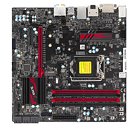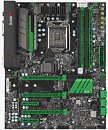Monday, February 11th 2019
SuperMicro Gearing for Launch of New Gaming-Grade Motherboards With PCIe Gen4 and DDR5 Wave
SuperMicro may not be household name in consumer motherboards right now, but they once were a decent alternative in the market - or so I've been told by people much more knowledgeable than me in that regard, as I never laid my hands on one. The company is now more known for its server products, where it has focused most of its attention in the past decade - an effort that gave it a good, third-place hold in that market. And if the company can command such a market share in a much more requirements-heavy environment such as the server market demands, then it's likely those design decisions and developments will find themselves trickling down to the consumer side in any sort of consumer, gaming-grade product the company decided to tackle.
To that end, SuperMicro is gearing up to re introduce themselves to the consumer market, accompanying the wave of new technologies coming to the market in a few years - namely, PCIe Gen 4 and DDR5 memory. The company seems to think that this will mark a perfect opportunity for a strong comeback to the consumer market - where they now only offer a handful of motherboard solutions for Intel's CPUs. One such example is the C9Z390-PGW motherboard, based on Intel's Z390 chipset - with its 10-phase VRM design, PLC chip for doubling of PCIe lanes, and 10 Gigabit Lan. But not only on said "typical" consumer motherboard techonologies will SuperMicro be delivering - if the company has its way, anything from 5G, IoT, Mission Learning and Artificial Intelligence can be incorporated for some use case or another on consumer-grade motherboards, thus providing an axis of penetration for SuperMicro - and its entire partner eco-system.The company is looking to leverage its IoT and server expertise that it has been cultivating in the last few years - with gaming grade products that will go up against the likes of ASUS Maximus and Gigabyte Aorus. Senior VP Vik Malyala told KitGuru that their company is also monitoring Ryzen's performance in the market, and reflected upon SuperMicro being one of the first companies to release Epyc-supporting motherboards. Perhaps we'll see the return of green to motherboards with a sexy tinge of environmentally-friendly operations.
Sources:
KitGuru, via TechSpot
To that end, SuperMicro is gearing up to re introduce themselves to the consumer market, accompanying the wave of new technologies coming to the market in a few years - namely, PCIe Gen 4 and DDR5 memory. The company seems to think that this will mark a perfect opportunity for a strong comeback to the consumer market - where they now only offer a handful of motherboard solutions for Intel's CPUs. One such example is the C9Z390-PGW motherboard, based on Intel's Z390 chipset - with its 10-phase VRM design, PLC chip for doubling of PCIe lanes, and 10 Gigabit Lan. But not only on said "typical" consumer motherboard techonologies will SuperMicro be delivering - if the company has its way, anything from 5G, IoT, Mission Learning and Artificial Intelligence can be incorporated for some use case or another on consumer-grade motherboards, thus providing an axis of penetration for SuperMicro - and its entire partner eco-system.The company is looking to leverage its IoT and server expertise that it has been cultivating in the last few years - with gaming grade products that will go up against the likes of ASUS Maximus and Gigabyte Aorus. Senior VP Vik Malyala told KitGuru that their company is also monitoring Ryzen's performance in the market, and reflected upon SuperMicro being one of the first companies to release Epyc-supporting motherboards. Perhaps we'll see the return of green to motherboards with a sexy tinge of environmentally-friendly operations.


31 Comments on SuperMicro Gearing for Launch of New Gaming-Grade Motherboards With PCIe Gen4 and DDR5 Wave
2 years is a long time to you? THAT is laughable. Two years goes by seemingly like a blink of an eye. I am waiting until 2021, I am aware when DDR5 is planned to be in the market, THAT is the main reason why I am waiting, 2 years is NOT a long time off.
See for example Athlon II:
Propus (45 nm SOI with immersion lithography)
Athlon II X4 630
Four AMD K10 cores chip harvested from Deneb with L3 cache disabled[6]
L1 cache: 64 kB + 64 kB (data + instructions) per core
L2 cache: 512 kB per core, full-speed
Memory controller: dual channel DDR2-1066 MHz (AM2+), dual channel DDR3-1333 (AM3) with unganging option
MMX, Extended 3DNow!, SSE, SSE2, SSE3, SSE4a, AMD64, Cool'n'Quiet, NX bit, AMD-V
Socket AM3, HyperTransport with 2 GHz
Die Size: 169 mm² [7]
Power consumption (TDP): 45 Watts or 95 Watts
First release
September 2009 (Stepping C2)
Clock rate: 2.2–3.1 GHz
That being said, I think it is a bit too early for DDR5, although I'd really love to see some CPU which supports it.
I think DDR4 brings too little to the table, so personally I skipped platform upgrade, however DDR5 will for sure be different due to doubling of the data rate.